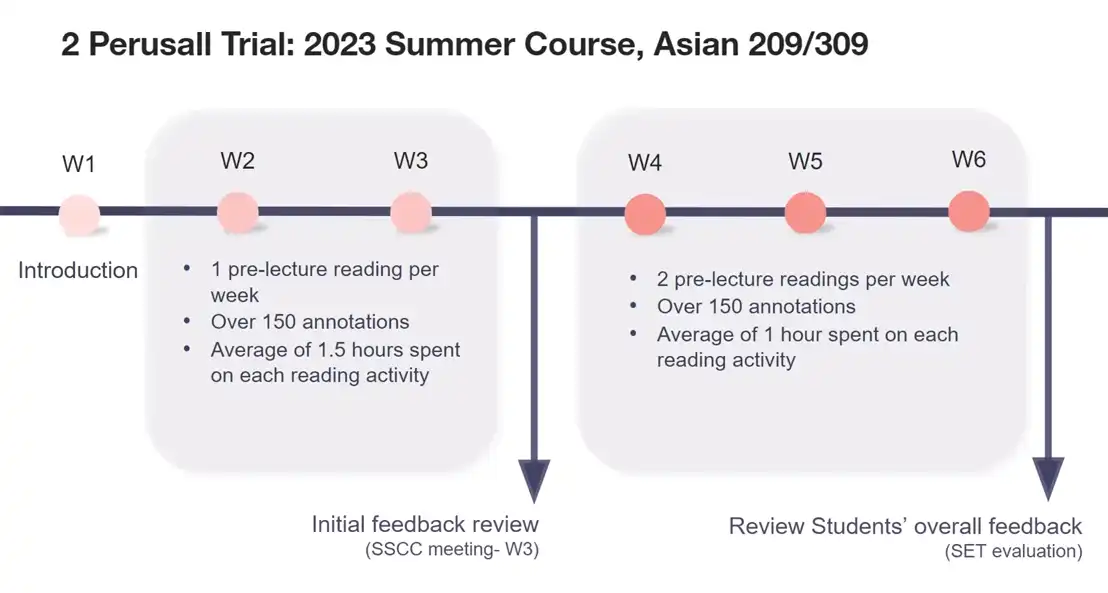Transforming student engagement with Perusall
Engaging students with academic readings is a common challenge for university instructors. Dr Lynne Park from Asian Studies used Perusall, a social annotation tool, to make readings more engaging and interactive for her students. The result? A more productive, insightful and relational educational experience for everyone.

Lynne, who teaches Asian and Korean content courses with Associate Professor Changzoo Song, faced this issue in her previous courses. She tried various strategies, such as weekly short essays, but found them to be limited in terms of text engagement and grading time. She wanted to find a better way to foster peer interaction and enrich class discussions. The solution came in the form of a tool that encouraged authentic student interaction with both the reading material and their peers.
The trial of Perusall
In 2023, through Learning Design CoI sessions Lynne discovered Perusall, a social annotation tool that integrates with Canvas and allows students to annotate texts and comment on each other’s annotations. She decided to pilot it in her summer course, Asian 209/309 “Transnational Asia: Korea and its Neighbours”. With 40 enrolled students, it was a perfect testing ground. Lynne used Perusall as a pre-lecture activity, requiring students to make three value-adding posts per week on the assigned readings.
Impact on student learning
The results were impressive. Within the first two weeks, students contributed over 150 annotations and spent an average of 1.5 hours per activity. The feedback from the Student-Staff Consultative Committee (SSCC) and the Student Evaluation of Teaching (SET) was positive, highlighting three key benefits of Perusall that contributed to building stronger relationality in class:
1. Engaging with course materials
Perusall encouraged students to engage deeply with the course material, rather than merely skimming it. Students were able to provide detailed responses, share personal experiences, connect examples to course concepts, and utilise other course materials. This enhanced their individual comprehension and prepared them for more nuanced discussions in class.
“The tutorials and the perusall readings were a very powerful way to engage with the material.”
2. Interactive and collaborative learning
Perusall enabled students to engage in discussions with their peers anonymously, creating a safe and non-threatening environment. Students appreciated the opportunity to share their ideas, thoughts, and feelings without feeling uncomfortable.
“I like how the teaching team has made it possible for us to interact with other people in our class and share our ideas/thoughts/feelings without making the student uncomfortable doing so.”
3. Peer-to-peer interaction
Perusall facilitated interaction among students, who were divided into smaller groups of up to five students for optimal discussion. Students valued the chance to read their peers’ perspectives on the course material, which gave them a more enriched learning experience through peer-to-peer interactive learning.
“The Perusall reading assignments is a very good way to keep us on top of our reading, and it is also a good way to read other students perspectives on the chosen reading.”
Challenges and lessons learned
Perusall was not without its challenges. Lynne had to consider the potential for inappropriate behaviour in the anonymous setting, the quality of student engagement, and the time investment for setting up and monitoring the tool. However, she found that Perusall’s built-in safeguards, such as instructor monitoring and the ability for students to flag comments, mitigated the risk of misconduct. She also addressed the issue of engagement quality by providing clear guidelines and expectations for the students. The benefits of Perusall outweighed the initial time commitment.
Lynne learned some valuable lessons from this trial, such as the importance of smaller discussion groups, the need for ongoing monitoring, and the effectiveness of Perusall’s automated grading feature. She plans to refine her use of Perusall, taking into account the lessons learned during this initial implementation.
“The Perusall (readings of the week) new setting for this course is an interesting one… There will also be other students who agree with and supplement my ideas. This allows us to communicate effectively in this space, which is very interesting.”
Conclusion
Lynne’s experience shows how Perusall can transform student engagement in university courses. By using this tool, she was able to create a collaborative digital learning environment that not only improved student learning outcomes but also enriched the educational experience for all involved.
Resources
Watch Lynne’s presentation on YouTube, held at the UoA Learning Design Community of Interest on 20 April, 2023.
Download Lynne’s slideshow (PDF 3Mb).

